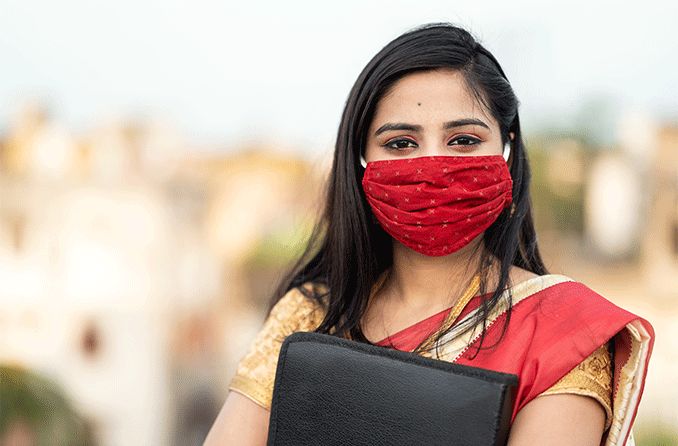Face masks reduce coronavirus spread, but they don’t protect your eyes

Using face masks to fight coronavirus transmission
To reduce the spread of the novel coronavirus, the World Health Organization (WHO) recommends that people wear face masks in areas where COVID-19 infection is widespread and distancing may be difficult.
While face coverings can provide a helpful layer of protection in many social situations, it’s also important to remember the other ways that coronavirus can spread — including through your eyes.
Coronavirus transmission through the eyes
The coronavirus can spread through contact with mucous membranes, including the conjunctiva — the thin, clear layer that covers part of the front of the eye and inner part of the eyelids.
Virus transmission through these membranes could lead to COVID-19 infection.
Respiratory droplets that enter through the mouth or nose are the most likely forms of virus transmission, but the conjunctiva makes the eye another possible transmission site to consider.
According to WHO guidance, “people who are in close contact (within 1 metre) with an infected person can catch COVID-19 when those infectious droplets get into their mouth, nose or eyes.”
Guidance published by the Ministry of Health and Family Welfare, along with countless other groups, stresses the avoidance of touching your eyes or other parts of your face with unwashed hands. This is because viruses on your hands can transfer through the mucous membranes on your face, including your eyes.
Supporting the information, a comprehensive study from Mount Sinai Health System has also found evidence that COVID-19 can directly infect the eyes. The study pointed out that the human eye was found to be infected 24 hours after being exposed to the virus. "This work was the result of a very productive collaboration from two very different scientific programs. More importantly, the data generated not only adds to our understanding concerning the biology of SARS-CoV-2, but the results also highlight the importance of washing hands, as rubbing one's eyes should now be viewed as an entry point for infection," said Dr. Benjamin tenOever of the research.
In addition to your face mask, eye protection — such as glasses, goggles or face shields, may also help protect the eyes from coronavirus spread, especially for those in medical settings.
An article published in the medical journal The Lancet even notes that “eye protection might be the missing key” to curbing viral spread.
SEE RELATED: Coronavirus transmission through the eyes
How face masks can reduce coronavirus transmission
In June 2020, the WHO recommended wearing face masks in public when social distancing was not possible, such as on mass transit or in other crowded areas.
The global organization said that masks could provide “a barrier for potentially infectious droplets.”
While the WHO had previously stated there was not enough evidence to say that healthy people should wear masks, emerging evidence showed that the wellbeing of the general population could benefit from frequent mask use.
Making your own face covering
Handmade face coverings can still offer some protection when other masks aren’t available to you.
The Ministry of Health and Family Welfare (MoHFW) created a comprehensive guide to creating your own face mask. In it, face coverings can be made using the following tools:
100% cotton material
Four cloth strips
Scissors
Sewing machine
If you don’t own a sewing machine, they present a second option that requires only a cloth and rubber bands.
For any homemade face cover, ensuring there isn’t a gap between the fabric and your face is critical, the Union Health Ministry says.
Handmade face cover precautions
The MoHFW notes that certain precautions should be taken with your cloth face covering:
Clean the mask, and your hands, before use.
Switch to a different mask if the current mask becomes damp or humid.
Never reuse a mask without cleaning it.
Never share a face covering.
When removing the mask, the guide recommends that you:
Remove it using the straps or strings (avoid touching the front of the mask).
For string covers, untie the string below before untying the string above.
Clean your hands with hand sanitiser (65% alcohol content and above) or soap and water (for 40 seconds or longer) immediately after removing the mask.
Drop the cloth mask into soap solution or boiling water (with salt added) to disinfect it.
Face masks are only one part of COVID-19 protection
The WHO uses the phrase “Do it all!” to emphasise how people should approach coronavirus safety measures.
In addition to wearing a mask when needed, the group recommends practising the following measures as much as possible:
Physical distancing
Keeping rooms well ventilated
Avoiding crowds
Cleaning your hands
Coughing into a bent elbow or tissue
In addition to the latest coronavirus guidance, the MoHFW has published a detailed, illustrated guide for home isolation during the pandemic.
Specific guidance may vary based on COVID-19 in your area. For the most up-to-date information about the pandemic, download the Arogaya Setu app (available both on Android and iOS), which helps you identify COVID-19 hotspots, follow the government's official websites like National Health Portal (NHP), mygov.in and more. Know the real-time updates through their social media handles, and also check with health agencies, municipal corporations and advisories in your state, union territory or district.
READ NEXT: How to avoid foggy glasses when wearing a face mask
Q&A: How is COVID-19 transmitted? World Health Organization. July 2020.
SARS-CoV-2: Eye protection might be the missing key. The Lancet. February 2021.
An illustrative guide on COVID appropriate behaviours. Ministry of Health and Family Welfare, Government of India. Accessed May 2021.
Coronavirus disease (COVID-19): Masks. World Health Organization. Updated December 2020.
Coronavirus disease (COVID-19) advice for the public: When and how to use masks. World Health Organization. Updated December 2020.
Comprehensive Mount Sinai study shows direct evidence that COVID-19 can infect cells in eye. EurekAlert! American Association for the Advancement of Science (AAAS). May 2021.
Page published on Friday, 21 May, 2021





